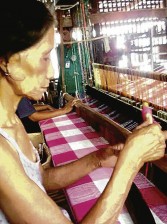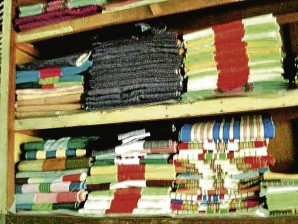New hope for Bangar’s ‘inabel’

HANDLOOMING survives in Bangar, La Union, courtesy of village women who inherited the craft from their elders. PHOTOS BY YOLANDA SOTELO
SEVERAL years ago, a group of Japanese businessmen arrived in the agricultural town of Bangar in La Union and offered to help mass- produce inabel, the handwoven fabric that the town has been creating for centuries.
There was also a group of foreign businessmen who wanted to computerize the handlooming process and make the fabrication of blankets, bath towels, pillow cases and fabrics for dresses and gowns faster.
The businessmen asked Wildreda Rivera, 59, a known weaver and trainer, to demonstrate the handlooming procedures, then tried to engage her services in computerizing the process.
Both instances showed that modernization is tugging at the seam of the age-old inabel weaving industry of Bangar. Local officials and residents, however, continue to resist these advances.
Far from earning more money, the residents would rather preserve the industry’s cultural practices and the unique appeal of their handwoven textiles, Councilor Irene Valencia-Taguiam says.
Article continues after this advertisement“Handlooming is our heritage. We want to preserve the uniqueness of our products which will lose their appeal if [these are] mass produced [and created by] machines. Besides, our townsfolk can produce beautiful designs even if they do not have formal schooling. It is an innate talent. We do not want to lose that identity to machines,” says Taguiam, also the town’s tourism officer.
Article continues after this advertisement“Besides, with the use the machines, Bangar residents will lose their chance to earn even if they stay at home, and after harvesting their palay,” she adds.
The town has always been synonymous with inabel. During the Spanish era, residents produced the textile starting from planting cotton, spinning the cotton into thread, dyeing and handweaving them into different materials.
Old women in Barangay Consuegra have only faint memories of the boom in the town’s inabel industry. They say the industry started to wane in the late 1960s.
Consuelo Noto Tan, 77, says her late mother left a spool of thread that was dyed at the village’s timbugan, the brick structure where cotton threads were dyed. But save for a braided strand, she had used all as wick for her oil lamp.
“I did not know they were important, or I would have saved them,” Tan says.
Backbreaking

“INABEL” fabric produced through traditional handlooming is turned into hand towels, bedsheets and material for gowns and dresses. PHOTOS BY YOLANDA SOTELO
Producing the fabric was a backbreaking activity in the olden days, Taguiam says.
Residents harvested cotton, which they themselves planted, after harvesting rice. They removed cotton seeds through an improvised equipment called ladditan.
After this process, the fiber would be spread on a bed of bagasse (sugarcane fibers) and the cotton compacted by beating them with sticks. The compacted fiber is rolled in bamboo sticks and spun through a process called panagtibbi. To strengthen the thread, residents would apply cooked starch on these.
The threads, now rolled in balls, were dyed at the timbugan, then handloomed into inabel.
These days, farmers in the town no longer plant cotton, and the industry is down to handweaving with threads, mostly imported, bought in large quantities from Metro Manila suppliers.
Taguiam says the inabel industry gave Bangar something to be proud of and helped its residents earn a living.
“The town was very fortunate to have an inabel industry. No one was idle and even children earned by engaging in the different phases of the industry that became a show window of values like industry, patience, and craftsmanship,” she says.
Sunset
But she admits the industry is nearing its sunset, with only a few families now engaged in handlooming.
One is retired school teacher Benita Castro, 84, who continues to operate a small shop to give livelihood to her village mates and help preserve the inabel industry.
Castro maintains 20 workers, including Rhodora Rivera and her daughter Roxanne. Roxanne, a Grade 4 pupil, can make at least 10 hand towels a day, earning her P40. Rhodora earns bigger by weaving bedsheets and towels.
Taguiam says many Bangar residents earn through subcontracting, with shops providing them with thread that they handloom at home during their free time.
Others can earn by making plecos, a tassel-like design sewed to a bedsheet’s edges. Sewing the plecos to the edges is another job for some women.
Taguiam laments the waning of the industry. “Sometimes, I blame those residents who told their sons and daughters to study hard to enable them to leave and get away from the inabel weaving industry, which they considered to be a very difficult work. What they did not realize was, because of inabel, they were able to produce professionals,” she says.